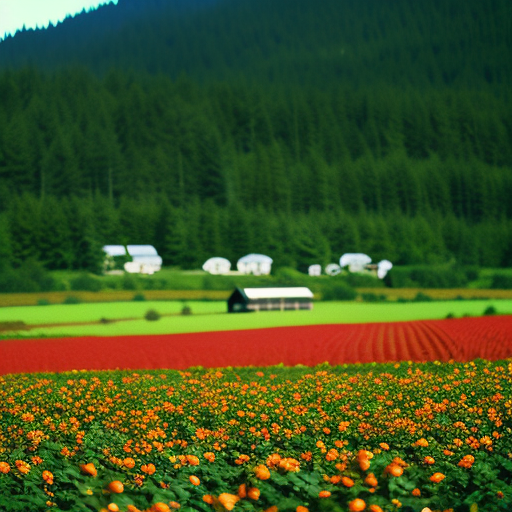
Thurston County Farmer Receives Grant for Sustainable Farming Practices
By Dylan Reubenking / For The Chronicle
Fighting Climate Change through Sustainable Farming
Warren Neth, the owner of Cosmic Carrot Farm in Yelm, has taken on the challenge of combating climate change through sustainable farming practices. In 2020, Neth lobbied for grant funding from the Washington State Sustainable Farm and Fields fund, and last month, he received approximately $8,000 to implement an alley-cropping system on his farm. This system aims to grow berries with high levels of antioxidants, contributing to the achievement of the Sustainable Development Goals (SDGs).
Alley-Cropping System for Sustainable Agriculture
An alley-cropping system involves planting rows of trees or shrubs to create alleys where agricultural or horticultural crops are grown. Neth’s farm utilized this agroforestry practice by planting annuals like vegetables between rows of perennials like berries. This approach not only supports local farmers but also helps reduce carbon emissions, increase biodiversity, and combat climate change.
Benefits of Alley-Cropping
The alley-cropping system implemented at Cosmic Carrot Farm offers several advantages:
- Sequestering an estimated 1.37 tonnes of carbon dioxide per acre per year, equivalent to driving 3,401 miles in a standard SUV.
- Reducing irrigation needs by lowering water evaporation in soils by 15% to 30%.
- Decreasing fertilizer requirements.
Planting Berries and Growing Vegetables
Cosmic Carrot Farm planted elderberry, aronia, and goumi berry in mid-February due to their high levels of cancer-fighting antioxidants. These berries will be used in value-added products such as gummies and teas. Additionally, vegetables and flowers will be grown between the rows of berries and sold at the farm stand, Yelm Farmers Market, and local restaurants in the spring.
Supporting Sustainable Farming in Thurston County
Cosmic Carrot Farm was one of four sites in the Thurston Conservation District to receive funding for sustainable farming practices. Dancing Goats and Singing Chickens Farm, Helsing Junction Farm, and Oyster Bay Farm also received funding. The Thurston Conservation District received a total of $52,798 from the Washington State Conservation Commission to support education about hedgerows and agroforestry practices.
Creating a Human-Scale Food System
Neth, along with representatives from the Thurston Conservation District, planted the alley-cropping system at Cosmic Carrot Farm. This farm spans approximately 8 acres and is located in Yelm. To promote awareness and education about sustainable farming practices, the farm hosted an educational workshop attended by 25 people. Neth emphasized the importance of creating a human-scale food system that takes into account the impacts of climate change on farms and the food industry as a whole.
Continuing Efforts to Fight Climate Change
Neth expressed his dedication to fighting climate change and highlighted the need for resilient farming systems that can withstand extreme weather events caused by climate change. To further promote sustainable farming practices and alley cropping, Cosmic Carrot Farm will host two spring markets where visitors can tour the farm and learn more about these initiatives.
Get Involved
To reserve a spot for a farm tour or learn more about Cosmic Carrot Farm’s sustainable practices, visit their website at https://www.cosmiccarrotfarm.com/. Local farms interested in receiving funding for similar sustainable practices can visit the Sustainable Farms & Fields fund website at https://www.scc.wa.gov/programs/sustainable-farms-fields.
SDGs, Targets, and Indicators in the Article
1. Sustainable Development Goal: SDG 13 – Climate Action
– Target 13.2: Integrate climate change measures into national policies, strategies, and planning.
– Indicator 13.2.1: Number of countries that have integrated mitigation, adaptation, impact reduction, and early warning measures into their development planning and budgeting.
2. Sustainable Development Goal: SDG 15 – Life on Land
– Target 15.1: By 2020, ensure the conservation, restoration, and sustainable use of terrestrial and inland freshwater ecosystems and their services.
– Indicator 15.1.1: Forest area as a proportion of total land area.
3. Sustainable Development Goal: SDG 2 – Zero Hunger
– Target 2.4: By 2030, ensure sustainable food production systems and implement resilient agricultural practices that increase productivity and production.
– Indicator 2.4.1: Proportion of agricultural area under productive and sustainable agriculture.
4. Sustainable Development Goal: SDG 12 – Responsible Consumption and Production
– Target 12.2: By 2030, achieve the sustainable management and efficient use of natural resources.
– Indicator 12.2.1: Material footprint, material footprint per capita, and material footprint per GDP.
Table: SDGs, Targets, and Indicators
| SDGs | Targets | Indicators |
|---|---|---|
| SDG 13 – Climate Action | Target 13.2: Integrate climate change measures into national policies, strategies, and planning. | Indicator 13.2.1: Number of countries that have integrated mitigation, adaptation, impact reduction, and early warning measures into their development planning and budgeting. |
| SDG 15 – Life on Land | Target 15.1: By 2020, ensure the conservation, restoration, and sustainable use of terrestrial and inland freshwater ecosystems and their services. | Indicator 15.1.1: Forest area as a proportion of total land area. |
| SDG 2 – Zero Hunger | Target 2.4: By 2030, ensure sustainable food production systems and implement resilient agricultural practices that increase productivity and production. | Indicator 2.4.1: Proportion of agricultural area under productive and sustainable agriculture. |
| SDG 12 – Responsible Consumption and Production | Target 12.2: By 2030, achieve the sustainable management and efficient use of natural resources. | Indicator 12.2.1: Material footprint, material footprint per capita, and material footprint per GDP. |
Analysis
1. Which SDGs are addressed or connected to the issues highlighted in the article?
The SDGs addressed or connected to the issues highlighted in the article are SDG 13 – Climate Action, SDG 15 – Life on Land, SDG 2 – Zero Hunger, and SDG 12 – Responsible Consumption and Production.
2. What specific targets under those SDGs can be identified based on the article’s content?
– Under SDG 13, the specific target is to integrate climate change measures into national policies, strategies, and planning.
– Under SDG 15, the specific target is to ensure the conservation, restoration, and sustainable use of terrestrial and inland freshwater ecosystems and their services.
– Under SDG 2, the specific target is to ensure sustainable food production systems and implement resilient agricultural practices that increase productivity and production.
– Under SDG 12, the specific target is to achieve the sustainable management and efficient use of natural resources.
3. Are there any indicators mentioned or implied in the article that can be used to measure progress towards the identified targets?
– Indicator 13.2.1: Number of countries that have integrated mitigation, adaptation, impact reduction, and early warning measures into their development planning and budgeting.
– Indicator 15.1.1: Forest area as a proportion of total land area.
– Indicator 2.4.1: Proportion of agricultural area under productive and sustainable agriculture.
– Indicator 12.2.1: Material footprint, material footprint per capita, and material footprint per GDP.
The article mentions the integration of climate change measures into national policies and planning, the conservation and restoration of terrestrial ecosystems, the implementation of sustainable agricultural practices, and the efficient use of natural resources. These indicators can be used to measure progress towards the identified targets.
SDGs, Targets, and Indicators
| SDGs | Targets | Indicators |
|---|---|---|
| SDG 13 – Climate Action | Target 13.2: Integrate climate change measures into national policies, strategies, and planning. | Indicator 13.2.1: Number of countries that have integrated mitigation, adaptation, impact reduction, and early warning measures into their development planning and budgeting. |
| SDG 15 – Life on Land | Target 15.1: By 2020, ensure the conservation, restoration, and sustainable use of terrestrial and inland freshwater ecosystems and their services. | Indicator 15.1.1: Forest area as a proportion of total land area. |
| SDG 2 – Zero Hunger | Target 2.4: By 2030, ensure sustainable food production systems and implement resilient agricultural practices that increase productivity and production. | Indicator 2.4.1: Proportion of agricultural area under productive and sustainable agriculture. |
| SDG 12 – Responsible Consumption and Production | Target 12.2: By 2030, achieve the sustainable management and efficient use of natural resources. | Indicator 12.2.1: Material footprint, material footprint per capita, and material footprint per GDP. |
Behold! This splendid article springs forth from the wellspring of knowledge, shaped by a wondrous proprietary AI technology that delved into a vast ocean of data, illuminating the path towards the Sustainable Development Goals. Remember that all rights are reserved by SDG Investors LLC, empowering us to champion progress together.
Source: chronline.com

Join us, as fellow seekers of change, on a transformative journey at https://sdgtalks.ai/welcome, where you can become a member and actively contribute to shaping a brighter future.






